The psychology of eating from the point of view of experimental, social, and applied psychology
Abstract
In this article, eating behavior is discussed from the point of view of various areas of psychology. First, tasting food and the perception of food palatability are discussed from the viewpoints of sensory and perceptual psychology and of physiological psychology. Second, the phenomenology of some social-psychological effects on eating behavior are introduced – for example, communication at the table, sociocultural variations in food liking/disliking, and emotional changes after eating. Third, these topics are integrated and are applied to food businesses. Two conclusions can be drawn: (1) understanding human eating behavior leads one to understand human beings themselves; (2) a psychological understanding of eating behavior not only gives one broad knowledge of psychology but also provides businesses and governments with hints for improving quality of life.
Received: 15.01.2014
Accepted: 27.02.2014
Themes: The 2nd Russian-Japanese forum of social sciences and humanities; Psychophysiology
PDF: http://psychologyinrussia.com/volumes/pdf/2014_1/2014_1_14-22.Pdf
Pages: 14-22
DOI: 10.11621/pir.2014.0102
Keywords: eating behavior, taste, food liking/disliking, communication at the table, food business
Eating behavior has attracted the attention of the public because of its importance to health, especially in relation to obesity. In this regard, there are many studies about eating behavior in the fields of neuroscience, clinical medicine, and nutrition. Abnormal behavior, such as overeating and the neural mechanisms that terminate eating, is studied in this kind of research; normal and daily eating behavior is an important topic in the field of psychology. In this article, I review some studies about human eating behavior in the fields of social psychology, sensory and perceptual psychology, physiological psychology, and consumer psychology.
Perception of tastes
What is taste? Many people misunderstand this phenomenon. Taste is the sense that is evoked during eating foods; it is not gustation. Gustation is the sensation that arises when the taste buds located in our oral cavity are stimulated by the flavors of foods. We can sense only five taste qualities through gustation: the five basic tastes (Figure 1). Sweet is the taste of sugar, and it signals an energy source. Umami, a term originally used to describe the taste of Japanese soup stock but now an international technical term, is the taste of amino acids, and it signals the presence of proteins. Salty is the taste of salt, and it signals a mineral source. Because these substances are essential for humans, we feel pleasure after tasting them. The other tastes are sour and bitter. These tastes, together with strong saltiness, are unpalatable to humans because foods or beverages with these tastes are harmful. No one would agree, however, that these basic tastes are enough to describe the taste of borsch or beef stroganoff. The taste of foods and beverages is not a sense felt with the tongue but is a more complicated sensation, more like a perception.
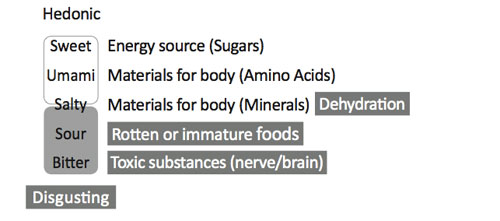
Figure 1. The five basic tastes.
The taste of juices or foods is changed or diminished when you drink or eat them with your nose closed. In other words, tasting is smelling. Tastes of foods and beverages depend not only on gustation but also on olfaction and somatosenses in the oral cavity. These sensations converge in our brain, as in synesthesia, so we cannot distinguish taste and flavor. These convergences are developed by our eating experience and are based on innate brain mechanisms. Thus, this phenomenon is called learned synesthesia (Stevenson, 2009). Both in rats (Sakai & Imada, 2003) and in humans (de Araujo, Rolls, Kringelbach, McGlone, & Phillips, 2003), these associations occur in the primary taste cortex, the insular cortex. Although the insular cortex is believed to play an important role in gustatory processing, it also receives olfactory information (Fu, Sugai, Yoshimura, & Onoda, 2004; Kettenmann, Hummel, Stefan, & Kobal, 1997). Furthermore, cognitive-neuroscientific research with MEG and fMRI show that the human insular cortex responds to olfactory stimulation directly from the primary olfactory cortex (de Araujo et al., 2003; Kettenmann et al., 1997). These findings explain why we misunderstand olfaction as taste or why we cannot distinguish olfaction from taste easily.
One more misunderstanding about taste is the taste map. In this map, it was suggested that sweetness was detected by the tip of the tongue but bitterness was detected at the back of the tongue. However, we do not have taste localization, as suggested by this map; rather, we can taste all qualities in any areas that have taste buds (Smith & Margolskee, 2001).
Social-psychological effects on eating behavior: Maslow’s hierarchy
Figure 2 presents a model of human motivation for eating based on Maslow’s motivation theory (Maslow, 1943). According to Maslow’s theory, human motivation develops from physiological motivation, such as hunger, sleepiness, loneliness. When physiological motivation is satisfied, safety motivation appears. The last and highest motivation is self-actualization. As each motivation is satisfied, the emotion of satisfaction is evoked. In the eating situation, satisfaction is comparable to the palatability of foods and beverages; thus in this model I made palatability the main concept.
Motivation for eating at the instinct level
At the physiological stage, foods and beverages that have a sweet or an umami taste (or both) are palatable. At the safety stage, we avoid foods and beverages that have a bitter or sour taste (or both) but eat foods and beverages with familiar tastes. These behaviors are also observed in rats, monkeys, and other omnivores.
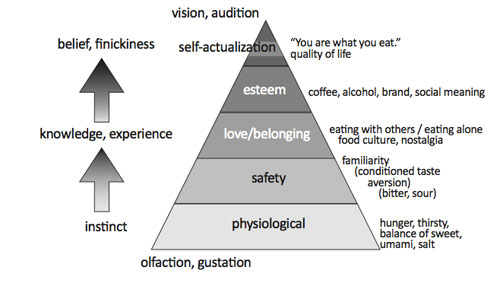
Figure 2. A model of human motivation for eating and for the palatability of foods and beverages. I have based this model on Maslow’s hierarchy of needs.
The behavioral tendency to avoid a novel taste is called food neophobia (Pliner and Hobden, 1992). In an experiment reported by Mennela and her colleagues (Mennela, Johnson, & Beauchamp, 2001), pregnant women were randomly divided into three groups (Figure 3). The women in the first group, CW, were asked to consume at least 200 ml of carrot juice daily in the third trimester of pregnancy. In the second group, WC, carrot juice was introduced in the lactation period. The last and control group, WW, did not consume carrot juice continually. Then the experimenters measured the baby’s consumption of carrot cereal. The babies in the WW group ate very little carrot cereal. This is a food neophobia. However the babies in the CW and WC groups did eat carrot cereal. They had tasted carrots via the amniotic fluid or via their mothers’ milk; therefore, the taste was familiar to them, and they had learned that the taste was safe. At this safety stage, we do not select foods through instinct but through our own experiences.
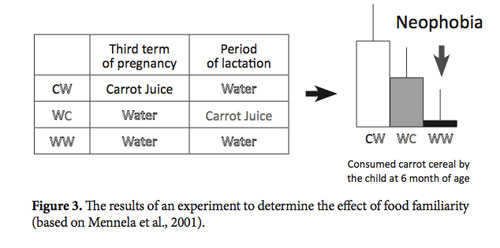
Figure 3. The results of an experiment to determine the effect of food familiarity (based on Mennela et al., 2001).
Motivation for eating at the knowledge level
The next stage in Maslow’s theory is motivation for love or belongingness. In Japan, the eating problem called koshoku has been gaining attention recently. Koshoku means eating alone; it has been found especially in children and the elderly. Koshoku leads people to have an unbalanced diet or to be undernourished. Also koshoku diminishes the palatability of foods. We feel satisfied when we eat foods with other people, especially with friends and family members. This emotion is related to the motivation for belongingness.
Some research has shown that palatability ratings of foods are affected by others’ ratings and by word by mouth. My colleagues and I studied the effect of knowing others’ palatability ratings of unfamiliar juices (Sakai, Korosaki, & Fuchimoto, 2013). In this study, participants were recruited to take part in a sensory study of beverages. They were asked to rate an unfamiliar juice on its palatability (along with their liking for it, its sweetness, and whether it had an aftertaste) while sitting at a table with others. Four of the people at the table had been coached to act as influencers, but the participants did not know that. The participants were asked to rate two kinds of lychee juice. After they evaluated one kind, the experimenter asked the participants to wait for a minute to evaluate the other lychee juice, and the experimenter left the laboratory. During the interval, one influencer at the table started to talk about the juice that they had tasted. All four influencers at the table said that the juice tasted bad. Some participants agreed with the evaluations of the influencers, but others did not. Then the experimenter entered the laboratory again and asked the participants to evaluate the other juice, which was actually the same juice. Comparing the ratings from the first trial (Pre) to those from the second trial (Post) revealed that the palatability ratings for the juice significantly decreased (Figure 4). Similar findings have been shown in other research (Robinson & Higgs, 2012).
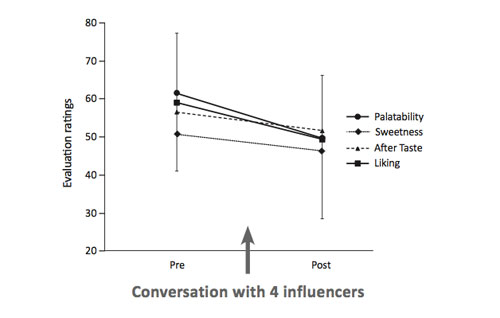
Figure 4. Participants’ palatability evaluation of lychee juice was decreased by knowing others’ negative evaluation of the beverage (based on Sakai et al., 2013).
These phenomena are discussed from the viewpoint of sympathy or of group pressure for belongingness, both of which are important concepts in social psychology. My colleagues and I are continuing our study of the effects of the social and psychological context of the eating situation on the palatability of foods and beverages and on contentment.
Motivation for eating at the belief level
The next stage in Maslow’s theory is esteem. At this stage, one motivates oneself to be respected by others and to feel self-esteem through others’ respect for oneself. Achievement of this stage leads to self-confidence and contentment. An example of this level is motivation to be rich or famous. In eating behavior, preference for certain brands is an example of this stage.
We studied the palatability of three brands of coffee-flavored lactic drinks (Sakai & Imada, 2012). The participants in the experiment tasted the same drink twice, once with the brand logo shown and once without the brand logo shown. One of the results was that beverages with the logo of the Siren in Greek mythology (Brand S) were judged to be 30 percent more palatable than those without the logo in a blind test. The only difference was the logo. The other two brands did not have such an effect. The palatability ratings for these two brands did not show any difference between those with and without brand logos. We interpreted the result as follows: the brand with the Siren has beverages in markets and coffee in their coffee shops.
In the second part of the experiment, we asked the question, Why does the logo make the beverage more palatable? We hypothesized that the participants evaluated the beverage of Brand S as more palatable and more real because they recalled that the brand had its own real coffee shop from their own memory. Thus we introduced another two brands (Brand T and Brand D), both of which have lactic drinks in the market and original coffee in their cafe. In this experiment, only Brand S was rated more palatable when the logo was shown than in the blind condition. This effect was not found with the other two brands. Then we used semantic differential methods and measured images for the brands. The key factor was fashion consciousness; participants who (based on their knowledge about the coffee shops) perceive a brand as more fashion conscious evaluate the beverage with the brand logo as more palatable.
In the third experiment, we made up a fictitious brand logo that young women found very fashion conscious. The participants were first introduced to the brand through fashion-conscious pictures and a logo. Then the participants were asked to drink and evaluate the coffee-flavored lactic drink. The beverage was the same as one of the coffee-flavored lactic drinks in the previous experiment (Brand T). With this fictitious brand, the beverage was more palatable and liked more than the real brand; we had successfully made a fashion-conscious brand. Although the beverage itself was the same, and only the brands were different, palatability ratings for the beverage showed a statistically significant difference. Palatability ratings of the new and fictitious brand were comparable to those of Brand S (the most palatable brand, Figure 5).
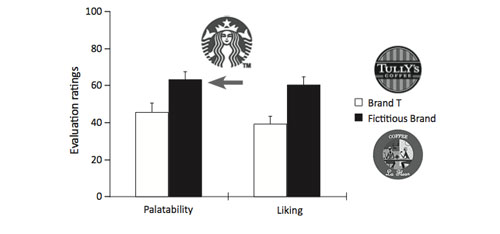
Figure 5. The effect of brands on the rating of beverages (based on Sakai & Imada, 2012).
These experiments showed that the images of brands affect the evaluation of their products. McClure and his colleagues (McClure et al., 2004) also showed that the Coca-Cola brand affects participants’ preference for cola beverages and that the brand evoked neural responses from the brain areas involved in processing taste and palatability but also in processing memory.
Palatability or contentment?
As I showed above, humans evaluate the palatability of foods and beverages based on their sensory properties, such as odors, tastes, and textures. Such a strategy is called bottom-up perception. Humans also evaluate the palatability of foods and beverages based on their brands, their origins, and their appearance. This strategy is called top-down perception. Humans evaluate the palatability of foods and beverages by both bottom-up and top-down perception.
In sum, experiments show that the palatability of foods and beverages is affected by our physiological states, by our psychological and social contexts, and by our beliefs. These factors are not included in the foods and the beverages but are evoked and integrated in our brain or cognitive processes. Some researchers, mainly in the field of food science, insist that we should classify palatability as being caused by the food factor or by the brain factor. From a psychological viewpoint, this classification is meaningless because palatability is the emotional experience evoked by eating foods or drinking beverages and not the chemical substances in the foods or the beverages.
Other researchers insist that we cannot assess our palatability exactly and that discussions like that in this article are meaningless. This argument is worth considering. Damasio (1999) proposed a theory called the somatic-marker hypothesis. In this theory, we do not cry because of sadness, but we feel sadness because of shedding tears. The best example of this hypothesis is an experiment on a fear-arousing suspension bridge reported by Dutton and Aron (1974). In that experiment, male participants passing by a suspension bridge wrote more sexual content in stories for the TAT questionnaire and showed a higher tendency to make contact with an attractive female interviewer than did the participants passing by a solid wood bridge. In this experiment, the participants mistook their fear for the attractiveness of the female interviewer. This is also an example of misattribution.
In the eating situation, palatability can also be misattributed and can be interpreted by using the somatic marker hypothesis. We feel contentment after eating foods and drinking beverages. This contentment is the emotional experience caused by activity in the parasympathetic nervous system. And the palatability of the foods is substituted for this contentment. This is a misattribution in an eating situation. We evaluate the dinner on a train as more palatable than that in an ordinary restaurant (Sakai, unpublished data). In an experiment, a lunch of curry and rice was sold in a train restaurant car and in a restaurant (the lunch itself was the same in both conditions). The participants misattributed the contentment of traveling by train to the palatability of the curry in the restaurant car. We are doing similar experiments using background music, communication at the table, and dishes as stimuli. These factors are not chemical substances in the foods and beverages, but they do have an effect on our palatability evaluations. Thus, we must consider these psychological properties of humans in studying or developing foods and beverages.
Other psychological factors in eating
I have reviewed here some psychological topics in eating behavior, but other research has been reported on these topics. For example, many behavioral neuroscientific researchers are studying the brain mechanisms involved in controlling appetite, in reward systems, in learning about what to eat, and so on. Other researchers have reported that classic feeding centers (such as the ventromedial hypothalamus and the lateral hypothalamus) and classic reward systems (such as dopaminergic neurons in basal ganglia) are not critical brain areas for eating behavior but are still important.
In other areas, many reports show that eating foods and drinking beverages eases human psychological stress (Komatsu, 2008; Sakai, 2009; Sakai et al., 2011). Some researchers have found that we have our own comfort foods—for example, chocolate or potato chips for Americans (Wansink, Cheney, & Chan, 2003), rice for the Japanese (Komatsu, 2008). When we feel depressed, we tend to eat those comfort foods to ease the negative emotion.
There are also many research topics on eating behavior in clinical psychology and health psychology. The problems of obesity, anorexia nervosa, and bulimia nervosa are not limited to developed societies. One study reports that we start eating not only because of hunger but also because of knowing that it is time to eat or seeing others eating (external eating behavior), and this eating pattern correlates with obesity (Van Strien, Frijters, Bergers, & Defares, 1986). We start eating also when we feel negative emotions such as sorrow, anger, and depression. This eating pattern is called emotional eating and has been shown to be correlated with bulimia and overeating (Van Strien et al., 1986).
Because eating is essential for living, to study the psychology of eating is to study the psychology of organisms. I welcome psychologists who join the study of eating behavior and hope many decide to do so.
References
Damasio, A. R. (1999). The feeling of what happens: Body and emotion in the making of consciousness. New York: Harcourt Brace.
de Araujo, I.E.T., Rolls, E. T., Kringelbach, M. L., McGlone, F., & Phillips, N. (2003). Taste-olfactory convergence, and the representation of the pleasantness of flavour, in the human brain. European Journal of Neuroscience, 18, 2059–2068. doi: 10.1046/j.1460-9568.2003.02915.x
Dutton, D. G., & Aron, A. P. (1974). Some evidence for heightened sexual attraction under conditions of high anxiety. Journal of Personality and Social Psychology, 30, 510–517. doi: 10.1037/h0037031
Fu, W., Sugai, T., Yoshimura, H., & Onoda, N. (2004). Convergence of olfactory and gustatory connections onto the endopiriform nucleus in the rat. Neuroscience, 126, 1033–1041. doi: 10.1016/j.neuroscience.2004.03.041
Kettenmann, B., Hummel, C., Stefan, H., & Kobal, G. (1997). Multiple olfactory activity in the human neocortex identified by magnetic source imaging. Chemical Senses, 22, 493–502. doi: 10.1093/chemse/22.5.493
Komatsu, S. (2008). Rice and sushi cravings: A preliminary study of food craving among Japanese females. Appetite, 50, 353–358. doi: 10.1016/j.appet.2007.08.012
Maslow, A. H. (1943). A theory of human motivation. Psychological Review, 50, 370–396. doi: 10.1037/h0054346
McClure, S. M., Li, J., Tomlin, D., Cypert, K. S., Montague, L. M., & Montague, P. R. (2004). Neural correlates of behavioral preference for culturally familiar drinks. Neuron, 44(2), 379–387. doi: 10.1016/j.neuron.2004.09.019
Mennela, J. A., Johnson, A., & Beauchamp, G. K. (2001). Prenatal and postnatal flavor learning by human infants. Pediatrics, 107, e88. doi: 10.1542/peds.107.6.e88
Pliner, P., & Hobden, K. (1992). Development of a scale to measure the trait of food neophobia in humans. Appetite, 19, 105–120. doi: 10.1016/0195-6663(92)90014-W
Robinson, E., & Higgs, S. (2012). Liking food less: The impact of social influence on food liking evaluations in female students. PLOS ONE, 7(11). Retrieved from http://www.plosone.org/article/info/ doi: 10.1371/journal.pone.0048858
Sakai, N. (2009). Effects of chemical senses on easing mental stress induced by solving puzzles. Japanese Journal of Research on Emotions, 17, 112–119 (in Japanese with English abstract). doi: 10.4092/jsre.17.112
Sakai, N., & Imada, S. (2003). Bilateral lesions of the insular cortex or of the prefrontal cortex block the association between taste and odor in the rat. Neurobiology of Learning and Memory, 80, 24–31. doi: 10.1016/S1074-7427(03)00021-2
Sakai, N., & Imada, S. (2012). Studies on the palatability of foods and beverages (1): The impact of brands. Poster session presented at the 2012 Annual Meeting of the Japan Association of Applied Psychology.
Sakai, N., Kurosaki, N., & Fuchimoto, J. (2013). The impact of communication on palatability evaluations of food and beverages. Poster presented at the 2013 Pangborn Sensory Science Symposium, Rio de Janeiro.
Sakai, N., Yoshimatsu, H., Ikenishi, T., Niikura, Y., Kondo, N., & Sako, N. (2011). The promoting effect of mint odor on recovery from the mental stress evoked by a simple summation task. Tohoku Psychologica Folia, 70, 26–35.
Smith, D. V., & Margolskee, R. F. (2001, March). Making sense of taste. Scientific American, 26–33.
Stevenson, R. J. (2009). The Psychology of Flavour. New York: Oxford University Press. doi: 10.1093/acprof:oso/9780199539352.001.0001
Van Strien, T., Frijters, J.E.R., Bergers, G.P.A., & Defares, P. B. (1986). The Dutch Eating Behavior Questionnaire (DEBQ) for assessment of restrained, emotional, and external eating behavior. International Journal of Eating Disorders, 5, 295–315. doi: 10.1002/1098-108- X(198602)5:2<295::AID-EAT2260050209>3.0.CO;2-T
Wansink, B., Cheney, M. M., & Chan, N. (2003). Exploring comfort food preferences across age and gender. Physiology & Behavior, 79, 739–747. doi: 10.1016/S0031-9384(03)00203-8
To cite this article: Sakai N. (2014). The psychology of eating from the point of view of experimental, social, and applied psychology. Psychology in Russia: State of the Art, 7(1), 14-22.
The journal content is licensed with CC BY-NC “Attribution-NonCommercial” Creative Commons license.









